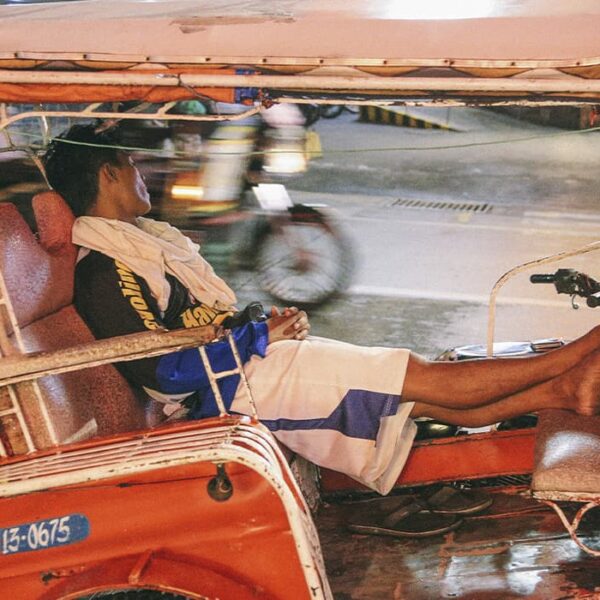What kinds of tuk-tuks have I ridden in Thailand, India, Sri Lanka, Laos, Cambodia, and Indonesia? They are said to be so called because of the sound of the two-stroke engine “knock-knock-knock-knock”. Let’s try to find out why the tuk-tuk remains the most popular transport in Asia, what they look like in different countries, and what to beware of when getting into a tuk-tuk.
What is a tuk-tuk and how it appeared
Tuk-tuks are sometimes called motor rickshaws or three-wheelers, or samoza, or tempo, or motorcycle cabs. Different countries may call them by different names, but almost everywhere you hear the simple name “tuk-tuk.
For centuries in Asia, bicycle rickshaws – bicycles with a sidecar for passengers – have been popular. Not the fastest cab, but cheap. Progress has added a motor to the bicycle and the tuk-tuk was born.
The tuk-tuk is faster than a bicycle and is still a cheap way to get from point A to point B.
Classic tuk-tuks are mass-produced in automobile factories. Specially trained people improve the engines, reduce fuel consumption and lower the cost of production. There are also completely homemade tuk-tuks, remade cars, constructors from the trailer and moped.
What do tuk-tuk passengers need to keep in mind? A tuk-tuk is a cheap vehicle. Tuk-tuks are made to save on everything, including comfort, safety, and suspension:
Long rides in such a vehicle can be very tiring,
Many tuk-tuks can be easily thrown overboard.
The classic three-wheeled tuk-tuk can be ridden in Bangkok. They act as a cab and guide around the city. Tuk-tuk drivers like to charge triple price for inexperienced tourists.
Ayutthaya is an ancient Thai city full of history and interesting tuk-tuks. Pictured below is a Daihatsu Midget tuk-tuk, which has been in production since 1957. This is one of the first mass-produced tuk-tuks.
Ayutthaya was for centuries the glittering capital of one of Southeast Asia’s most powerful kingdoms. If you have an extra day in Bangkok or Pattaya, be sure to go to Ayutthaya.
In Krabi province, Koh Lanta, Phuket and other tourist regions of southern Thailand you can find tuk-tuks of absolutely different designs:
- A motorcycle cab with a sidecar for 2-3 passengers for short distances – usually within the same beach or township.
- tuk-tuk as a multi-seat cab with powerful speakers and bright light-music – specialized tourist transport of resort towns in Thailand, which can easily accommodate 6 – 8 people.
Tourist tuk-tuks can be flung out on the pavement when starting abruptly. In the Thai news about such cases they say something like: “very drunk tourists had a bad time and ended up in the hospital”.
In the north of Thailand you can find impressive hybrids of powerful motorcycles and trailers. For some reason I immediately imagine a scene from a sci-fi movie involving them.
While in Thailand tuk-tuks are becoming more and more a tourist vehicle, in Sri Lanka tuk-tuks are still an inexpensive means of transportation for locals.
Sri Lankan tuk-tuks are almost always as shiny as if they were for sale or prepared for a contest for the best tuk-tuk. The owners carefully wash their tuk-tuks, polish them to a shine and decorate them in every possible way. They use chrome pipes, homemade doors, various dodgers, and painted wheels.
To get from the airport to the hotel, it’s better to order a classic car – read more in the article How and where it’s better to order a cab from the Colombo Airport.
In India, on the other hand, you can see the dirtiest and ugliest wrecks. And it’s incredible how these tuk-tuks keep going.
Tuk-tuks in India are ruthless. How many passengers do you think you can fit in one little tuk-tuk? At least a couple of dozen, and if necessary, a third dozen will fit.
In Cambodia, the question is simpler: moped + trailer = tuk-tuk. A moped has a trailer hitch welded to it, which can be quickly hitched or unhitched if desired. Cheap and practical.
On the bends, this design can easily tip over, especially if it has too many passengers.
We once booked a transfer from Siem Reap airport at the hotel and a tuk-tuk came to pick us up. We had to pack very tightly with three suitcases, a baby stroller, and two backpacks of photo equipment. And then we drove for 40 minutes, swallowing the thick Cambodian dust.
After such an unforgettable experience, when traveling with a child, I book transfers to and from the airport at the trusted Kiwi Taxi and Intui Travel websites.
If you decide to visit the world famous Angkor temple complex on your own, without a tour, you have three alternative transportation options – a bicycle, a tuk-tuk or an air-conditioned car. The third option is undoubtedly the most comfortable.
In Laos you can see any tuk-tuks and almost all of them will be in bad shape. I have an impression that they take to Laos everything that has served its purpose in Thailand.
